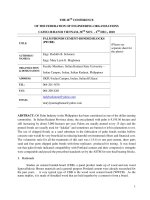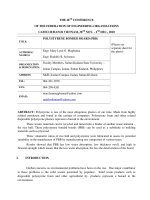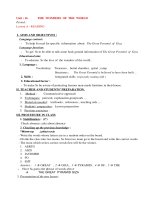20 PRINCIPLES GUIDING THE WORLD FEDERATION OF CHIROPRACTIC
Bạn đang xem bản rút gọn của tài liệu. Xem và tải ngay bản đầy đủ của tài liệu tại đây (3.55 MB, 24 trang )
<span class="text_page_counter">Trang 1</span><div class="page_container" data-page="1">
20 PRINCIPLES
Advancing awareness, utilization and integration of chiropractic internationally
</div><span class="text_page_counter">Trang 2</span><div class="page_container" data-page="2">World Federation of ChiropracticSuite 601, 160 Eglinton Avenue East,
Toronto, Ontario M4P 3B5 Canadawfc.org
© World Federation of Chiropractic 2020
</div><span class="text_page_counter">Trang 3</span><div class="page_container" data-page="3">For over 30 years, the World Federation of Chiropractic (WFC) has been at the forefront of the global development of chiropractic.
Representing the interests of the profession in over 90 countries worldwide, the WFC defends, promotes and advocates for the profession across its 7 world regions.
The publication of the WFC's 20 Principles set out the guiding values that drive our work. Our Strategic Plan 2019-2022, approved unanimously at the 2019 WFC Assembly of Members in Berlin, sets out four key pillars: support, empowerment, promotion and advancement. In achieving our goals, we are aware of the diversity of ways in which
chiropractors serve their patients, which is often driven by social determinants of health, culture and philosophy of healthcare delivery. The plan is the product of a careful analysis of our
strengths and priorities and a desire to ensure that it has relevance and meaning to our members and stakeholders.
These 20 Principles explain what we stand for. They articulate our commitment to advance and develop the chiropractic profession for the benefit of patients and the public and to represent the interests of our national association members around the world.
As a living document, the WFC 20 Principles will be regularly reviewed and, where necessary, updated. We hope that they will be received in the spirit in which they are intended and serve to provide clarity as to our purpose, support to the profession, and empowerment to many
thousands of chiropractors whose dedication and commitment is transforming the lives of people around the world.
</div><span class="text_page_counter">Trang 4</span><div class="page_container" data-page="4"><i>1</i><sup>We envision a world where people of all </sup>ages, in all countries, can access the benefits of chiropractic.
Chiropractic is a profession whose members bring relief to millions around the world each year. For the past 125 years, doctors of chiropractic have faithfully served their communities, bringing relief to suffering and improving the quality of life of those whose lives have been affected by pain and disability.
Chiropractic is present in over 100 nations, yet there remains many people who, because of social, economic, environmental or political reasons, are unable to access care.
Our vision is that regardless of geographic location or financial circumstances, all people may enjoy access to chiropractic. We consider
that such access should be a right, not a privilege and that it should be available to the many, not to the few.
In their offices and clinics around the world, chiropractors see patients of all ages, from newborns to the elderly. The widespread
popularity of pediatric chiropractic care, reflected in public surveys, suggests that it is highly
valued by parents, while chiropractic-led programs to support the elderly have
transformed the lives of those hampered by mobility issues.
Around the world, chiropractors are changing lives for the better.
</div><span class="text_page_counter">Trang 5</span><div class="page_container" data-page="5"><i>2</i><sup>We are driven by our mission to advance </sup>awareness, utilization and integration of chiropractic internationally.
There are currently an estimated 120,000 chiropractors in the world. Around seventy per cent practice in North America, with a significant majority licensed in the United States.
In many parts of the world, particularly in Africa and Asia, there are very few chiropractors and access to care is limited. Because of low
numbers in these regions, people are unaware of the benefits of chiropractic care.
As a global organization, we are committed to advancing awareness of chiropractic, including the education and training of chiropractors, their scope of practice, and their expertise in
managing neuromusculoskeletal disorders.
We advocate for the greater utilization of
chiropractic within national, state and provincial health systems. With low back pain alone
constituting the leading cause of years lived with disability worldwide, there is a clearly identified need for the services that can be provided by doctors of chiropractic.
We are supportive of the drive to eliminate silos in health care and believe in the value of
integration of chiropractic services as part of a multidisciplinary approach. We are mindful that collaboration can occur regardless of a
chiropractor's individual practice circumstances.
</div><span class="text_page_counter">Trang 6</span><div class="page_container" data-page="6"><i>3</i><sup>We believe that science and research </sup>should inform care and policy decisions and support calls for wider access to chiropractic.
Evidence supports the role of chiropractors in the effective management of spinal pain and
disability. With international guidelines now advocating for non-surgical, non-pharmaceutical approaches to most forms of back pain,
chiropractors are well-placed to take their place as valued members of people's health care teams.
We support evidence-based approaches to chiropractic care, informed by the best available scientific research. Current scientific evidence favors many care interventions used by
chiropractors, including those following a biopsychosocial model.
Health policy to address the global burden of spinal pain and disability must also be founded on an analysis of the evidence and be created in consultation with all spine care professionals, including chiropractors.
Our vision is a world where everyone may enjoy universal access to chiropractic so that
populations may thrive and reach their full potential.
For the benefit of patients and the public, we support the inclusion of chiropractic services in all health systems.
</div><span class="text_page_counter">Trang 7</span><div class="page_container" data-page="7"><i>4</i><sup>We maintain that chiropractic extends </sup>beyond the care of patients to the promotion of better health and the
well-being of our communities.
Chiropractic is a health profession concerned with the diagnosis, treatment and prevention of mechanical disorders of the musculoskeletal system and the impact of these disorders on the function of the nervous system and on general health. There is an emphasis on manual treatments, including spinal adjustment and other joint and soft tissue manipulation.
As primary, portal-of-entry health professionals, chiropractors are responsible for the continuous assessment of the general health status of patients under their care. Chiropractors also engage in campaigns to promote better health in their communities, in workplaces
and online.
We support the role of chiropractors as health advocates. In many parts of the world, access to health services is sparse. Chiropractors may support their communities through health promotion activities to help people restore, maintain or enhance their optimal state of health.By focusing on factors that improve human health and well-being, rather than on factors that cause disease, chiropractors take a
whole-person approach to biological,
psychological and social elements of individual health.
</div><span class="text_page_counter">Trang 8</span><div class="page_container" data-page="8"><i>5</i><sup>We champion the rights of chiropractors </sup>to practice according to their training and expertise.
Chiropractors are governed by legislation in each state in the United States, every province in Canada and all territories in Australia, as well as in many other countries around the world. In many of these jurisdictions, scope of practice is defined by law; in others, scope is not defined and chiropractors are free to practice as they wish within the framework of general laws and regulations.
Chiropractors undergo an extensive program of training that involves many thousands of hours of education. Rigorous assessment ensures that upon graduation chiropractors are deemed safe and competent to practice.
We recognize that chiropractic training may vary in emphasis and content and acknowledge the role of accreditation agencies in measuring educational content against key competencies.We believe that it serves the best interests of patients and the public when chiropractors are permitted to exercise their professional skills and competencies consistent with their education, including certified and accredited post-graduate training.
In keeping with a hallmark of all health professionals, we support the importance of lifelong learning and the value of continuous professional development.
</div><span class="text_page_counter">Trang 9</span><div class="page_container" data-page="9"><i>6</i><sup>We promote evidence-based practice: </sup>integrating individual clinical expertise, the best available evidence from clinical
research, and the values and preferences of patients.
Evidence-based practice has been universally adopted across health care as the standard of care.
It comprises three elements. Firstly, the needs and preferences of the individual patient are taken into account, which are in turn influenced by cultural norms, beliefs, attitudes and
expectations.
Secondly, evidence-based practice relies upon the experience and expertise of the clinician, drawing on their wisdom, knowledge, training
and skills.
Thirdly, in making decisions about care,
chiropractors are informed by their judicious use of the best available evidence from clinical
research, recognizing that there are cases where high quality evidence from research may not yet exist, or it may be inconclusive.
We promote evidence-based practice that represents these fundamental elements, acknowledging that specific circumstances will dictate individualized approaches to care.
</div><span class="text_page_counter">Trang 10</span><div class="page_container" data-page="10"><i>7</i><sup>We are committed to supporting our </sup>member national associations through advocacy and sharing best practices for the benefit of patients and society.
Our constituent members are national
associations of chiropractors in seven regions around the world. Some of these associations have many thousands of members while others, in countries where chiropractic is less well established, have very few. We dedicate ourselves to working with all members by identifying their needs and by supporting and empowering them to reach their goals.
We advocate for chiropractic to be legally recognized in countries that are not currently subject to laws or regulation. We support member associations with attendance at high level meetings involving government officials and health policy makers.
Our network of experts means that we can support the work of our members with access to global data on chiropractic, repositories of
research evidence, and governance documents. We share national and international guidelines and support the development of professional standards and codes of practice.
As the only chiropractic organization in official relations with the World Health Organization, we have access to resources at the highest level of global health. Our memberships of the
Non-Communicable Disease Alliance and the Global Rehabilitation Alliance allow us to advocate for greater recognition of spinal pain and disability as a global burden.
</div><span class="text_page_counter">Trang 11</span><div class="page_container" data-page="11"><i>8</i><sup>We acknowledge the role of chiropractic </sup>care, including spinal adjustment, to enhance function, improve mobility,
relieve pain and optimize well being.
We recognize that chiropractic is not all about treating back pain and neck pain. Although it's what they're best known for, chiropractors have a broad scope of practice that extends beyond the spine. From the management of sports injuries, to the prevention of disability, to treating joint pain and headaches in children and adults, today's doctors of chiropractic are multi-skilled to deliver effective, non-surgical,
non-pharmaceutical health care.
As well as the relief of pain, people seek chiropractic care to restore joint function and improve and maintain their health. A well
functioning neuromusculoskeletal system helps people to move better, work better and live
better. This is especially important in older people, where the ageing process may be accompanied by other health issues and where challenges with mobility may make every day activities more difficult.
Chiropractors use standard orthopedic and neurological tests as part of their assessment and use other tests such as diagnostic imaging when clinically indicated. They are highly skilled at detecting and correcting joints that are stiff and restricted, but also may use soft tissue techniques, prescribe exercise, give therapeutic and lifestyle advice or refer to other health professionals.
</div><span class="text_page_counter">Trang 12</span><div class="page_container" data-page="12"><i>9</i><sup>We support research that investigates the </sup>methods, mechanisms, and outcomes of chiropractic care for the benefit of
patients, and the translation of research outcomes into clinical practice.
As more evidence emerges, both from research conducted within the chiropractic profession and from related professions, new knowledge helps chiropractors to better understand which
approach to care is likely to be most effective.Clinical research conducted around the world has investigated the impact of chiropractic care, including spinal manipulation or adjustment, for a range of conditions. There remain gaps in our understanding about the way that spinal
manipulation works and how it may be related to outcomes that are observed and reported in clinical practice. Research is ongoing that is
investigating the effects of spinal manipulation on the nervous system and other systems of the body.
One of the challenges in health care is ensuring that the evidence from research is effectively synthesized into clinical practice. We work with knowledge translation experts to support our national association members and chiropractors in communicating the latest research and
explaining how it is relevant to the care of patients and the public.
</div><span class="text_page_counter">Trang 13</span><div class="page_container" data-page="13"><i>10</i><sup>We believe that chiropractors are </sup>important members of a patient's healthcare team and that
interprofessional approaches best facilitate optimum outcomes
Over the past decade, health professionals have recognized the value of people-centered,
multidisciplinary teams, which can lead to better health outcomes and enhanced levels of patient satisfaction.
Interprofessional collaboration benefits patients by breaking down traditional silos and providing an environment where health professionals can communicate and understand their respective contributions, strengths and skills.
Regardless of their geographic locations or practice status, most chiropractors can engage in interprofessional, team-based care. Advances in telemedicine mean that information can be
readily shared and chiropractors can participate in patient-centered discussions.
As chiropractic grows, more people experience the benefits of care and include doctors of
chiropractic as valued members of their personal health care team. Evidence also shows that patients want their health care team members to communicate with each other.
We support interprofessional health care. By sharing their perspectives and listening to those of colleagues in other disciplines, chiropractors benefit their communities and align with our vision and mission for chiropractic.
</div><span class="text_page_counter">Trang 14</span><div class="page_container" data-page="14"><i>11</i><sup>We believe that chiropractors should be </sup>responsible public health advocates to improve the well being of the communities they serve.
Public health is the science of protecting and improving the health of people and their communities. Being an advocate for public health benefits people from all sections of society.
We support people-centered care. We
understand that not everyone who benefits from chiropractic may necessarily be a patient and that the work of many chiropractors extends to supporting the health and well-being of their communities.
We support WHO initiatives including those related to diet and physical activity, healthy ageing, anti-tobacco, injury prevention, and infectious disease prevention campaigns.
Chiropractors around the world promote public health as advocates of healthy lifestyles.
Each year, on October 16, we coordinate World Spine Day, the largest spine-focused, public health event in the world. By highlighting the burden of spine pain and disability, chiropractors in each of our 7 world regions reach out and promote the benefits of spinal well-being to the public as advocates of physical activity and self management to reduce the burden of low back pain and neck pain in society.
By promoting best practices in public health, chiropractors support their patients and the communities in which they live and work.
</div>








